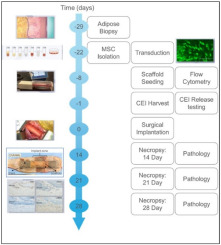Sumati Sundaram, Karissa L. Paquin, Tina Roffidal, Greg Booker, Sherif Soliman, Jeff Bouchard, Elisaveta Todorova, Brett G. Zani, Raffaele Melidone, Saverio La Francesca, and William Fodor. "Early tissue growth and cell fate determination following segmental esophageal repair using a tissue engineered esophageal implant composed of a polyurethane scaffold seeded with autologous adipose-derived mesenchymal stromal cells."
 Introduction: End-stage or chronic esophageal disease may eventually lead to surgical intervention and could potentially result in an esophagectomy, followed by a gastric pull-up or colon interposition procedure. Biostage's Cellspan™ Esophageal Implant (CEI) is designed to repair and replace full-circumferential esophageal surgical resections (≤6 cm) using autologous adipose derived mesenchymal stromal cells (Ad-MSCs) seeded on a retrievable polyurethane scaffold. The use of a segmental implant has the advantage of preserving the native non-diseased esophageal tissue as well as the stomach or intestinal tissue following esophagectomy. The mechanism of action, the fate of the Ad-MSC component (biodistribution) and the process of early tissue regrowth/wound repair following implantation remains to be elucidated.
Introduction: End-stage or chronic esophageal disease may eventually lead to surgical intervention and could potentially result in an esophagectomy, followed by a gastric pull-up or colon interposition procedure. Biostage's Cellspan™ Esophageal Implant (CEI) is designed to repair and replace full-circumferential esophageal surgical resections (≤6 cm) using autologous adipose derived mesenchymal stromal cells (Ad-MSCs) seeded on a retrievable polyurethane scaffold. The use of a segmental implant has the advantage of preserving the native non-diseased esophageal tissue as well as the stomach or intestinal tissue following esophagectomy. The mechanism of action, the fate of the Ad-MSC component (biodistribution) and the process of early tissue regrowth/wound repair following implantation remains to be elucidated.
Methods: CEIs seeded with Ad-MSCs transduced with green fluorescent protein (GFP) were implanted into a pig model of esophageal segmental resection. A 5 cm full-circumferential esophageal resection was performed followed by CEI implantation using an end-to-end anastomoses to bridge the gap between the 2 native esophageal ends. Cell fate and tissue development were assessed at 14 (N = 3), 21 (N = 3), and 28 days (N = 3), post-CEI implantation.
Results: All animals in all groups exhibited a contiguous biologic esophageal conduit with a denuded patent lumen at necropsy. Epithelial cell proliferation/regrowth was evident from both anastomotic margins toward the implant center. Morphometric analysis indicated an increase in epithelial regrowth and a concomitant reduction in denuded tissue from day 14 to day 28. Histological evaluation revealed fibrovascular tissue and neovascularization on the adventitial side, with no discernible differences in tissue organization between 14 and 28 day implants. The majority of GFP + cells were on the abluminal esophageal surface and localized around vascular structures. No GFP + cells were detected in lymph nodes or on retrieved scaffolds.
Conclusion: These findings support luminal continuity by day 14 post-implantation with Ad-MSC derived pericytes contributing to the neo-fibrovascular tissue. Morphometric analysis of the lumenal surface indicates that the process of lumenal re-epithelialization results from epithelial cell proliferation from the implant margins towards the center of the implant.
Journal of Immunology and Regenerative Medicine; Available online 9 December 2022, 100068

